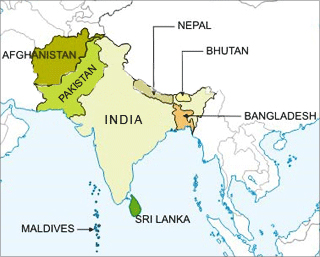The recent cancellation of the 19th summit of South Asian Association for Regional Cooperation (SAARC) that was scheduled to take place in Islamabad on November, 15 and 16, has led to serious doubts as to whether SAARC can fulfill its objectives and remain as a useful forum that would be beneficial to the eight nations that are members of the SAARC.
Acute fissures amongst SAARC members
India cited Pakistan’s involvement in the September 18 terrorist attack at an Army camp in Uri town of Kashmir, in which 19 soldiers died, as the reason for its decision to boycott the summit. When a few other member countries such as Afghanistan, Bangladesh, and Bhutan supported India’s stand and decided not to attend the 19th summit at Islamabad, there was no option for Nepal, the Chairman of SAARC to cancel the summit.
Apparently, this has created considerable dissatisfaction in Pakistan, creating serious fissures amongst SAARC nations.
Potential strength not being realized
SAARC, with member states of Afghanistan, Bangladesh, Bhutan, India, Nepal, Maldives, Pakistan and Sri Lanka, comprises 3% of the world’s area, 21% of the world’s population and around 9% of the global economy. With such strength, SAARC has the potential to emerge as an active center of power in the world, with prospects of emerging as an individual economic and trade entity.
For this to happen, there has to be unity and sound understanding among the SAARC nations, which are conspicuous by absence.
Very little to show
With its secretariat based in Kathmandu, SAARC is supposed to promote the development of economic and regional integration.
Of course, The South Asia Preferential Trading Agreement (SAPTA) was signed in the 7th summit at Dhaka in April 93, but it has not yet been adequately operationalized so far. .The other proposal to establish South Asian Food Reserve and South Asian Development Fund have also has not been implemented yet.
Similarly, declarations on enhancing political cooperation and promotion of mutual trust and understanding reiterated in each summit have registered little success
Founded in 1985, even after 30 years, SAARC has nothing to show to claim that it has achieved even a fraction of its objectives.
Inherent weakness
SAARC suffers from inherent weakness, as its member countries like Nepal Afghanistan and Maldives face political instability. Though Bangladesh and Sri Lanka have democratically elected stable governments, both the countries have faced and have to tackle divisive internal forces. Pakistan is another member of SAARC, where several militant and terrorist groups are suspected to exist.
There are constant armed conflicts between India and Pakistan and a fluid and conflict-ridden border between Pakistan and Afghanistan.
The leadership of countries who are members of SAARC such as Nepal, Afghanistan, Pakistan, and India has often criticized another member of SAARC, as interfering in the internal political affairs.
What future for SAARC?
Now, it is reported that Pakistan is exploring the possibility of creating a greater South Asia economic alliance that would include China, Iran, and neighboring South Asian republics.
Obviously, SAARC is not a cohesive force and lacks the necessary climate to emerge as a regional force. Given such circumstances, one wonders as to whether SAARC has relevance anymore.
With .the members of SAARC, except perhaps India, remaining as economically, technologically and industrially weak and vulnerable nations, there is not much that one member can do to help the other.
At best, it can be said that SAARC can emerge as a robust and attractive market for the developed countries in Asia, Europe and Americas, that can bring investments and contribute to the growth in the region. For this to happen, SAARC members need to stay together, which is not going on.
The question that one cannot but ask is as to whether SAARC remains relevant anymore and whether it has a future at all, since there is no indication that member states of SAARC would sink differences and see eye to eye on various issues, for which elegant cooperation and goodwill is an essential need, basic necessity, and prerequisite.
Possibly, with the summit being canceled due to animosities between members, SAARC is likely to become a letter pad organization with technically not being wound up but ceasing to have important functions to remain relevant.
If the present impasse in SAARC would persist and continue, it is inevitable that SAARC would become a laughing stock in the eyes of the world.

